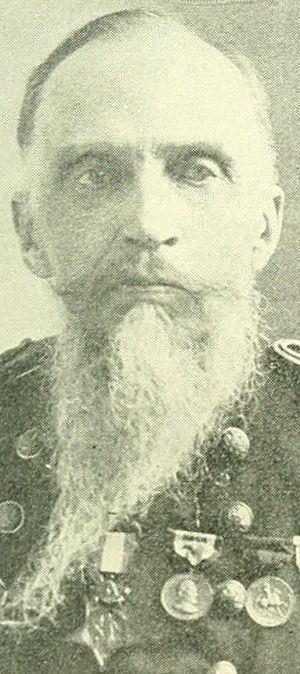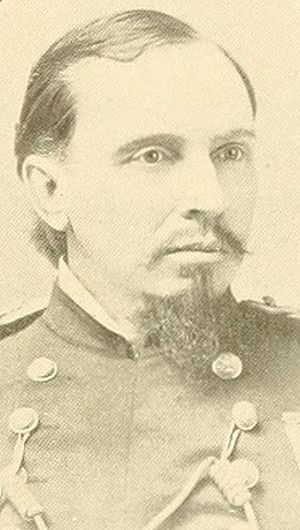Henry Clay Wood facts for kids
Quick facts for kids
Henry Clay Wood
|
|
|---|---|

From Volume 2 of 1911's Norwich University, 1819–1911
|
|
| Born | May 26, 1832 Winthrop, Maine |
| Died | August 30, 1918 (aged 86) Portland, Maine |
| Buried | |
| Allegiance | Union |
| Service/ |
United States Army Union Army |
| Years of service | 1856–1896 |
| Rank | |
| Unit | U.S. Army Infantry Branch |
| Battles/wars | American Civil War |
| Awards | Medal of Honor |
| Spouse(s) | Mary Frances Lord (d. 1866) Mary Ann (Ferguson) Bassett (d. 1909) |
| Children | 2 (including Brigadier General Winthrop S. Wood) |
Henry Clay Wood (born May 26, 1832 – died August 30, 1918) was a dedicated officer in the United States Army. He rose through the ranks to become a brigadier general. He was a veteran of the American Civil War, fighting for the Union Army. He is especially remembered for his bravery at the Battle of Wilson's Creek. For his actions there, he was awarded the Medal of Honor, one of the highest military honors.
Contents
Early Life and Education
Henry Clay Wood was born in Winthrop, Maine, on May 26, 1832. His parents were Samuel and Florence Wood. He went to school in Winthrop. Later, he attended academies in Yarmouth and Farmington.
In 1850, he started studying at Bowdoin College. He earned his first degree, a bachelor of arts, in 1854. After college, he first tried studying medicine. However, he soon decided to study law instead. He became a lawyer in 1856. In 1857, he received his master of arts degree from Bowdoin.
Joining the Military
Henry's father was a major general in the Maine Militia. In 1856, Henry served on his father's staff as a major for several months. During this time, he also took military classes at Norwich University. In 1874, Norwich University gave him a bachelor of science degree.
In June 1856, Wood officially joined the U.S. Army. He became a second lieutenant in the Infantry. His first assignment was with the 1st Infantry Regiment in Texas. In May 1861, he was promoted to first lieutenant. He then joined the 11th Infantry Regiment.
Service in the Civil War
The American Civil War began in 1861. Henry Clay Wood was sent to Missouri. He joined a larger force led by General Nathaniel Lyon. General Lyon worked to keep Missouri from joining the Confederacy. He also wanted to stop federal weapons from falling into Confederate hands.
Battle of Wilson's Creek
On August 10, 1861, the Battle of Wilson's Creek took place. General Lyon's forces were outnumbered and lost the battle. Lyon himself was killed. However, his efforts helped the Union gain time. This allowed them to send more troops and secure Missouri.
Wood commanded a mounted rifle company during this battle. He was wounded in the fighting, suffering a head injury. Many of his men were also killed or wounded. Despite this, Wood kept his company together. He then led them in an organized retreat. They pulled back from the fighting area while under heavy enemy fire. In 1893, Wood was awarded the Medal of Honor for his bravery at Wilson's Creek.
Later War Service
In October 1861, Wood was promoted to captain. He worked as a recruiting officer for General John C. Frémont. Later, he served at the War Department. He helped with mustering (gathering) troops and managing money.
In June 1864, he was promoted to major. In March 1865, he received two special promotions. He became a brevet lieutenant colonel for his heroism at Wilson's Creek. He also became a brevet colonel for his excellent work in the Provost Marshal's office. A "brevet" rank is an honorary promotion for good service. It doesn't always come with higher pay or command.
After the Civil War
After the war ended, Wood continued his military career. He served as an assistant adjutant in Georgia. Then he moved to the Department of the Columbia. This department covered parts of the Pacific Northwest.
Later, Carl Schurz, the Secretary of the Interior, asked for Wood's help. Schurz was in charge of policies for Native Americans. Wood was asked to talk with tribes in the Pacific Northwest. His goal was to convince them to move to Indian reservations.
Later Career and Retirement
Wood was promoted to lieutenant colonel in February 1887. In November 1893, he became a colonel. He served in various departments, including the Department of the Lakes, the Department of Texas, and the Department of Dakota.
Henry Clay Wood retired from the Army in May 1896. On April 23, 1904, he was promoted to brigadier general on the retired list.
After retiring, Wood lived in New York City. He was involved in several community groups. These included the Freemasons and the Society of Mayflower Descendants. In 1909, he moved to Farmington, Maine.
Death and Burial
Henry Clay Wood passed away in Portland, Maine, on August 30, 1918. He and his wives are buried at Arlington National Cemetery. This is a famous military cemetery in Virginia.
Family Life
In 1860, Henry Clay Wood married Mary Frances Lord. She was from Standish, Maine. Mary Frances died in 1866. In 1869, he married Mary Ann (Ferguson) Bassett from Washington, DC. Mary Ann Wood passed away in 1909.
Henry and his first wife had two sons. Harry Clifford Wood was born in 1863. He became a lawyer. Their second son, Winthrop Samuel Wood (1865–1937), also had a military career. He graduated from the United States Military Academy. Winthrop served in the Spanish–American War and World War I. He also reached the rank of brigadier general, just like his father.
Legacy
Mount Claywood is a mountain in the Olympic Mountains in Washington state. It was originally called Mount Clay Wood. It was named in honor of Henry Clay Wood.


